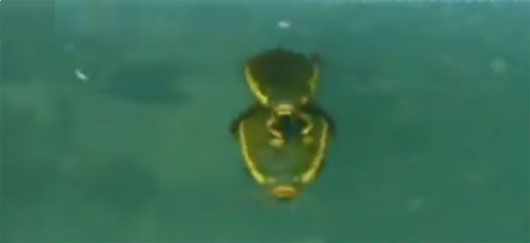How is the beetle 'love' underwater?
Taiwan scientists have finally discovered a "weapon" that helps scuba-diving bugs balance to successfully mate underwater.
Research by Dr. Kai-Jung Chi from Chung Hsing National University (Taiwan) and colleagues revealed how hard bristles on the male beetle's legs attach to the body of the female beetle with the sucking tip . Come on.
According to Interface magazine, the team directly measured the force of the "mounting tool" on the legs of two different scorpions. Dr. Chi explained, the ability to bind plays an essential role in the survival of beetles.

"Once mating is complete, the male must be separated from the female to get oxygen from the surface of the water, otherwise they may die due to lack of oxygen. In other words, the male beetle must attach and separate from the child. the faster the better, " said Chi.
Images taken under a microscope show that one of the two scorpions was chosen by Dr. Chi's group, which has a more primitive structure, and used a connected "weapon" of the shovel table top. male legs hair. The remaining scorpion has developed rounded suckers at the end of each leg, making them look like tiny straws.
Although the tiny suction tubes produce a stronger bond, the more primitive beetle's hair is compensated by another ability. The tiny ducts on the more primitive fur seem to "leak" as a glue, helping the male stick to his partner's body.
In addition, the fact that more primitive feathers of the beetles form weaker binding forces and are able to move around the body more freely than synonymous, the male beetle has the ability to resist abnormal swimming movements of children when "she" wants to shake off the unwanted mistress.
According to Dr. Chi, suckling eyelashes act as a typical straw, while shovel table hair acts as a fast, easy-to-control and overturning strip.
The discovery not only revealed an evolutionary trait in scorpion bugs, but understanding it could also inspire the design of engineering devices that help to mount underwater.
- The assassin unleashes the beetle at mating
- 9 odd effects of love
- A beetle named after the young environmental activist Greta
- Strange facts that science explains about love
- 4 wrong thoughts about love that not everyone knows
- New discoveries of love
- Interesting facts about love
- The beetle of the beetle
- Not an alien, this is the most exotic giant bug on Earth
- 'What is love?' through a scientific perspective
- 4 new discoveries about love that amaze you
- The underwater record for 73 days
 Why do potatoes have eyes?
Why do potatoes have eyes? 'Tragedy' the world's largest carnivorous life: Death becomes ... public toilet
'Tragedy' the world's largest carnivorous life: Death becomes ... public toilet Tomatoes were once considered 'poisonous' for 200 years
Tomatoes were once considered 'poisonous' for 200 years Detecting microscopic parasites on human face
Detecting microscopic parasites on human face Shocking new research: Male mosquitoes can also suck blood!
Shocking new research: Male mosquitoes can also suck blood!  What substance is in male papaya flowers that is rumored to 'kill cancer cells'?
What substance is in male papaya flowers that is rumored to 'kill cancer cells'?  Discovering super rare fish in the sea
Discovering super rare fish in the sea  Scientists discover how termite colonies all female survive
Scientists discover how termite colonies all female survive  Amazed animals make love for 14 hours, 'finished' then rolled out... dead
Amazed animals make love for 14 hours, 'finished' then rolled out... dead  'Cold on the back' of the female mantis chewing on her partner's head while mating
'Cold on the back' of the female mantis chewing on her partner's head while mating 